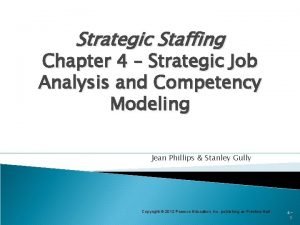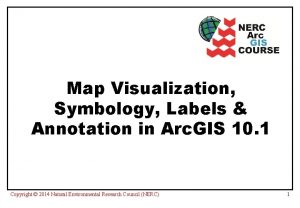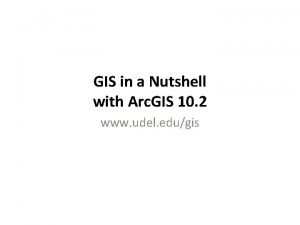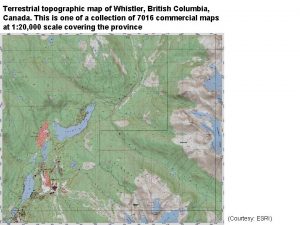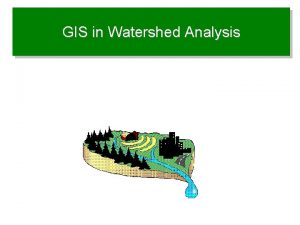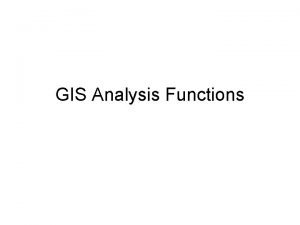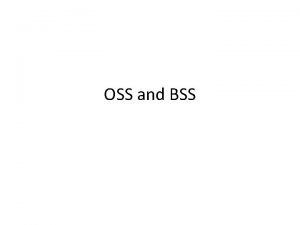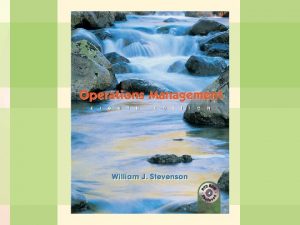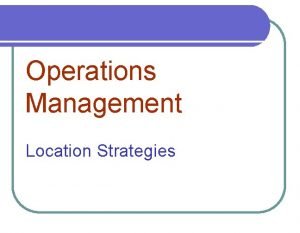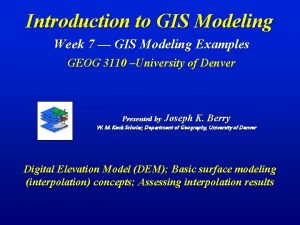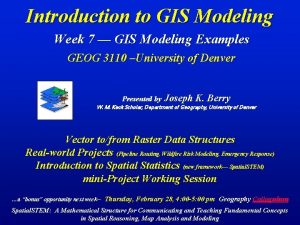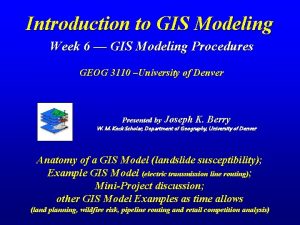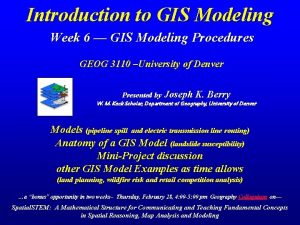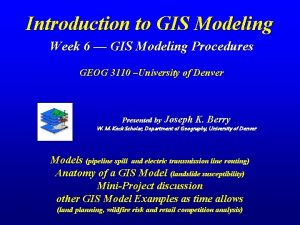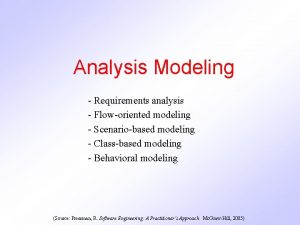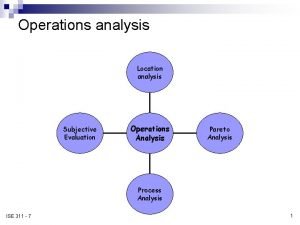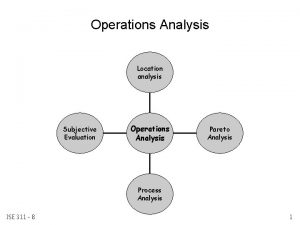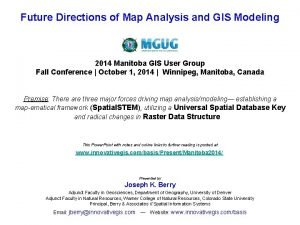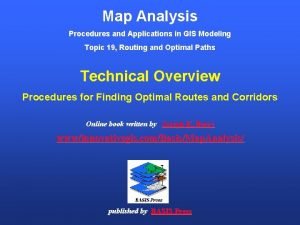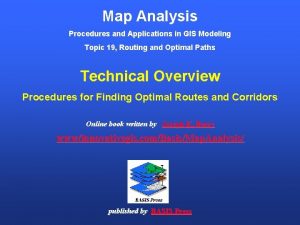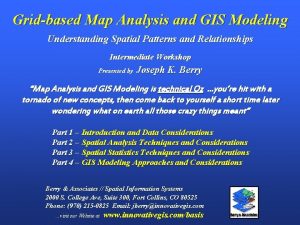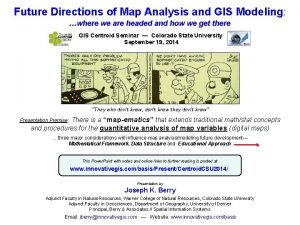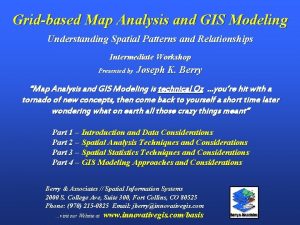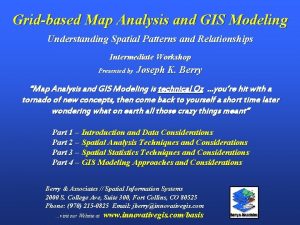GIS Modeling Classes of Map Analysis Operations GIS





















- Slides: 21

GIS Modeling Classes of Map Analysis Operations GIS Modeling logically sequences map analysis operations (Spatial Analysis, Surface Modeling and Spatial Data Mining) to solve spatial problems… Thinking with Maps (Berry)

Decision Support Systems Framework Three elements of a GIS Model (Berry)

Suitability Modeling (Full Exercise #8) Relative Suitability Mountain Property Development (Berry)

Capturing Model Logic (Command Script) The logical sequence of map analysis operations is contained in a Command Script that can be easily changed to simulate different scenarios (Berry)

Suitability Modeling (Comparing Scenarios) (Berry)

Transmission Line Siting Model Existing Powerline Goal – identify the best route for an electric transmission line that considers various criteria for minimizing adverse impacts. Proposed Substation Houses Criteria – the transmission line route should… Roads ü Avoid areas of high housing density ü Avoid areas that are far from roads Sensitive Areas Elevation ü Avoid areas within or near sensitive areas ü Avoid areas of high visual exposure to houses Houses (Berry)

Siting Model Flowchart (Model Logic) Model logic is captured in a flowchart where the boxes represent maps and lines identify processing steps leading to a spatial solution Avoid areas of… High Housing Density Far from Roads In or Near Sensitive Areas High Visual Exposure …build on this single factor (Berry)

Siting Model Flowchart (Model Logic) Model logic is captured in a flowchart where the boxes represent maps and lines identify processing steps leading to a spatial solution Step 1 Identify overall Discrete Preference (1 good to 9 bad rating) Start End Step 2 Generate an Accumulated Preference surface from the starting location to everywhere Start End Step 3 Step 2 Step 1 Step 3 Identify the Most Preferred Route from the end location (Berry)

Step 1 Discrete Preference Map Calibration Weighting HDensity RProximity SAreas VExposure (Berry)

Step 2 Accumulated Preference Map Splash Algorithm – like tossing a stick into a pond with waves emanating out and accumulating costs as the wave front moves (Berry)

Step 3 Most Preferred Route …steepest downhill path “re-traces” the accumulated cost wave front that got there first (Berry)

Generating Optimal Path Corridors (Berry)

Power and Pipeline Routing (Advanced GIS Models) …see Application Paper GW 04_routing Infusing stakeholder perspectives into Calibration and Weighting …of Engineering considerations, Natural Environment consequences and Built Environment impacts Global routing solution identifies the Optimal Route (blue line) and Optimal Corridor (crosshatched) …see Application Paper GITA_Oil&Gas_04 (Berry)

Real World Routing Application (Processing Schematic) 5) The best route and corridor is determined for conditions favoring each group’s perspective and one where all are equally weighted– Four alternative routes reflecting different perspectives Stakeholder Groups Built B E N (avg) BEN Calibration Simulations BEN Exclusions Engr. 4) Relative importance weights for the Criteria Maps within each group are used to calculate an overall preference map Weighting Natural Building Density Visual Exposure Proximity Schools Categories Excluded 3) The categories on each Criteria Map are calibrated to a range of 1=best to 9= worst for siting a transmission line Criteria etc. Proximity Buildings 1) Locations that prohibit siting are eliminated from consideration Existing Utilities Transporation Land Cover Proximity Excluded Floodplane etc. Slope Hydrography Public Lands 2) Information that influence transmission line siting are identified (Berry)

Identifying the Routing Decision Space Combining alternative corridors identifies the decision space reflecting various perspectives E=1 N=1 B=5 E=5 N=1 B=1 E=1 N=5 B=1 E=1 N=1 B=1 Weighting one stakeholder group over the others derives Alternative Corridors that emphasize stakeholder particular concerns …the routing decision space is identified by combining the Alternative Corridors Geo. World magazine feature article on the EPRI_GTC project http: //www. geoplace. com/gw/2004/0404 pwr. asp

Acquire Additional Detailed Field Data The Siting Team collects additional very detailed field data within the decision space defined by the Alternative Corridors

Investigating the Alternative Routes (GIS-derived ) “Simple” Discrete Preference Surface shown as background … avoid areas in warmer tones (red) and favor locating in cooler tones (green) Standardized Alternative Routes Built Natural Engineering Simple Built-up Area (avoid) Less Suitable Open Field (favor) More Suitable …based on the detailed field data, the Siting Team investigates the impacts of the Alternative Routes Note: if the additional detailed data warrants, the Siting Team can re-locate portions of the GIS-derived Alternative Routes but a formal statement of the reasons are required; alignment of a potential route outside of the decision space requires an exception petition (analogous to land use re-zoning)

Evaluating Potential Routes (selecting the Preferred) …the relative merits of top few potential routes are discussed by the Siting Team and then ranked to identify the most preferred route GIS-derived Scores Expert Judgment

Prescription Increasing Abstraction — Description The Softer Side of GIS (Beyond Mapping III Epilog) Philosopher's Levels of Cognitive Levels of Understanding Judgment Map Types Facts Base – Earth circumference is 24, 900 mi – Britney Spears was born 12/2/1981 – Britney Spears is 25 years old – measured features, conditions and characteristics Data – all facts – the temperature is 32 o F : (fact) Spatial Processing Collect – direct acquisition of primary information (e. g. elevation) Where we have been in GIS Calculate Derived Information Relevant Facts – facts within a context – the temperature is 32 o F Knowledge – interrelationships among relevant facts – inferred conditions and characteristics (implied fact) – uses algorithms to derive secondary information (e. g. , slope) Perception Interpreted – it sure is cold – it’s not cold – adjusted to reflect expertise and presumption (Alaskan) (judgment) – I hate this weather – potential solution within model logic and expression – “what if” investigation of alternative scenarios (conjoined judgment) (multiple perspectives) (Floridian) Calibrate/Weight – translates information into relative scales (preference & importance) Where we are headed in GIS Modeled Simulate Opinions/Values Wisdom – actionable knowledge (Floridian) – I love this weather (Alaskan)

Where Have We Been? Computer Mapping -- Spatial d. B Management -- GIS Modeling ü Spatial Analysis — “contextual” relationships within and among mapped data (Reclassify, Overlay, Distance, and Neighbors) ü Surface Modeling — maps the “spatial distribution” and pattern of point data (Map Generalization, Spatial Interpolation and Others) ü Data Mining — “numerical” relationships within and among mapped data (Descriptive, Predictive, and Prescriptive) From mapping to Spatial Reasoning …changing our Map Paradigm Thinking with Maps! (Berry)

More on Map Analysis and GIS Modeling www. innovativegis. com/basis Online Papers Online Materials Hardcopy Books Software (Berry)
 Helen erickson biography
Helen erickson biography Relational vs dimensional data modeling
Relational vs dimensional data modeling Este classe e subclasse
Este classe e subclasse Pre ap classes vs regular classes
Pre ap classes vs regular classes Simulation kelton
Simulation kelton Dfd fragment
Dfd fragment Requirements modeling in system analysis and design
Requirements modeling in system analysis and design Competency model vs job analysis
Competency model vs job analysis Manufacturing systems modeling and analysis
Manufacturing systems modeling and analysis Strategic job analysis and competency modeling
Strategic job analysis and competency modeling Polk county gis florida
Polk county gis florida Arc gis map
Arc gis map Arc gis map
Arc gis map Whistler gis map
Whistler gis map Gis watershed analysis
Gis watershed analysis Gis analysis functions
Gis analysis functions Gis analysis functions
Gis analysis functions Bss map
Bss map Location planning and analysis
Location planning and analysis Break even analysis operations management
Break even analysis operations management What is the objective of location strategy
What is the objective of location strategy Bubble map pdf
Bubble map pdf









